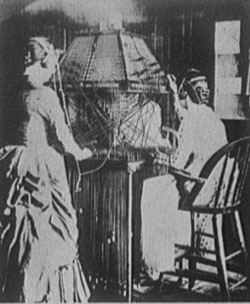Telephone switching
Telephone Switching
Calling someone on the telephone is possible because of the use of what communications engineers call “switching” technology. The numbers on a telephone keypad relay information to a device much like a computer, which uses the numbers to direct your call to the appropriate destination.
The first telephone switching technology was the manual switchboard. A switchboard was usually a board or box where all the telephone lines in a local area terminated. At the terminal points, plugs were installed so that wires could be connected between any two lines. When a customer placed a call, a light, bell, or other signal alerted the operator, who answered the call. The operator asked the caller whom they wanted to call, and used wires to connect the caller and the callee. The first commercial switchboard opened in 1878 to serve the 21 telephone customers in New Haven, Connecticut.
Telephone switchboards grew larger and more elaborate as more and more people got telephones in the late 19th century. They also began to be designed with more and more features, such as bells or lights that told the operator when a line was busy. There were so many telephone subscribers by about 1910 that inventors and telephone companies around the world began to look for ways to make telephone switching automatic. The most famous of the independent inventors was Almon Strowger. On 12 March 1889 in Kansas City, Missouri, he applied for a patent on a system of automatic telephone switching; the patent was granted on 10 May 1891. It was the first such system to meet with commercial success, being first implemented in La Porte, Indiana in 1892. But the automatic switching he invented was not perfected for nearly a decade. After the turn of the century, Strowger switches and dial telephones became common in independent (non-Bell) telephone exchanges in the United states. But it was only in 1919 that the American Telephone and Telegraph (AT&T) began giving customers in its Bell System exchanges telephones with dials on them, and installing automatic switching equipment in its central offices. It took decades to complete the conversion, one exchange at a time. While all telephones in Manhattan had dials by 1930, The last manual Bell telephones, on Catalina Island, California, were retired only in 1978.
A dial telephone sent electric pulses down the line to the central switch, where they were detected and used to establish a connection automatically. Most areas of the United States had automatic switching and dial telephones by about 1950, and operators were only necessary for long-distance calls. These, too, were mostly automated by about 1965. Most automatic switching equipment used electromechanical apparatus to route calls and make connections until the 1960s, when transistors replaced the relays. And dial telephones themselves were replaced by touch tone phones with keypads. The first touch tone phones, which used musical tones instead of pulses, entered service in 1963. The transistor was invented at AT&T when engineers were looking for a replacement for the electromechanical relay. Engineers working on the first computers were also interested in telephone switching equipment, because the switching processes of computing were similar to automatic telephone switching. The term “switchboard” is not used today, but has been replaced by “switch.” Today’s telephone switches come in many different varieties to serve local, long-distance, international, satellite, and cellular telephone needs in addition to digital data.

